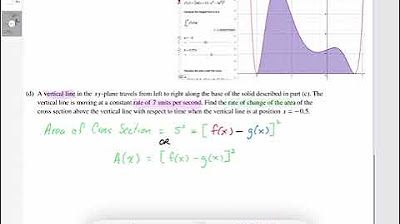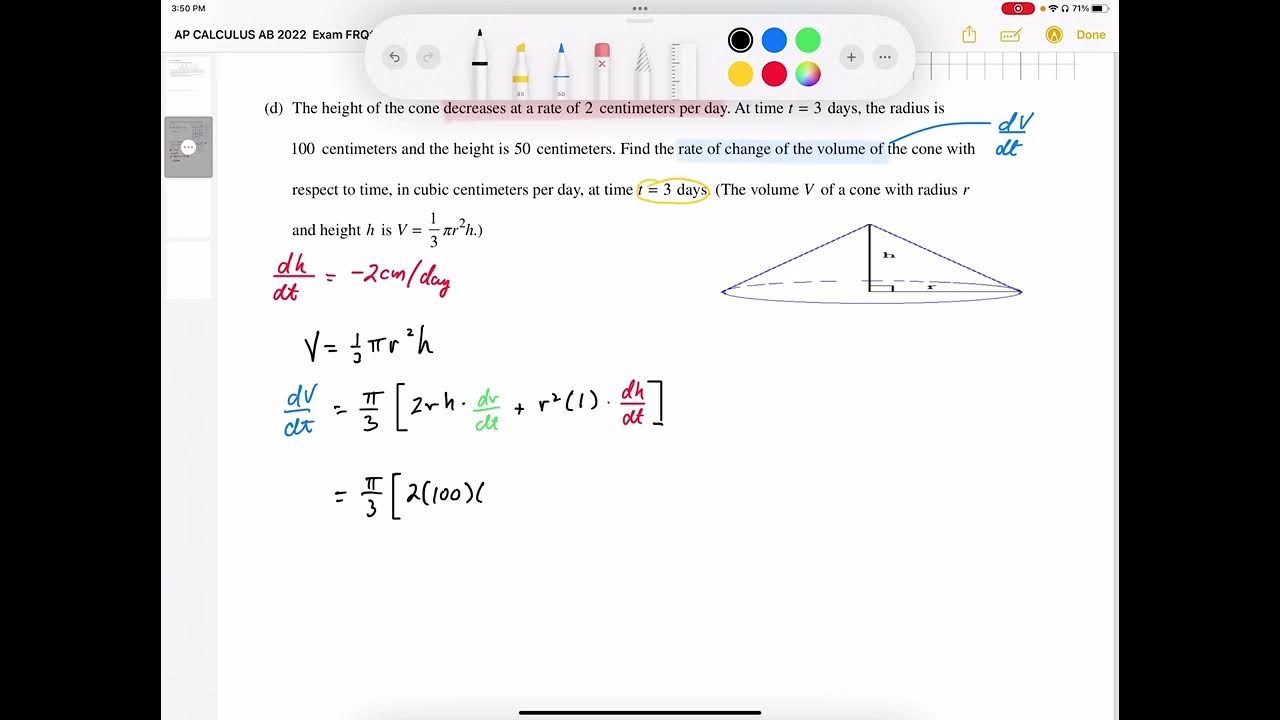Introduction to Related Rates
TLDRThe video script introduces the concept of related rates, focusing on the use of derivatives to determine the rate of change with respect to time. It explains the process through examples involving the differentiation of various functions and concludes with two problems that demonstrate how to find the derivatives of x^2 + y^2 = z^2 and x^2 + y^2 = 25 with given dx/dt and dy/dt values. The solution involves finding dz/dt when x and y are specified, highlighting the analytical approach to problem-solving in related rates.
Takeaways
- 📚 The concept of related rates involves using derivatives to determine how quickly quantities change with respect to time.
- 🧮 Implicit differentiation is a crucial technique needed for finding derivatives in related rate problems, such as the derivative of y cubed with respect to x.
- 📈 When differentiating with respect to time, terms like dy/dt and dx/dt are introduced to represent the rates of change of the respective variables.
- 🌟 The rate of change is essentially the speed at which something changes over time, which is central to understanding related rates.
- 🔢 To solve related rate problems, one must first identify the given values and the variable of interest, such as the value of x and finding dy/dt.
- 💡 The process involves solving the initial equation for the unknown variable and then differentiating both sides with respect to time.
- 📊 When solving for rates, it's important to consider all possible solutions, as seen with y being positive or negative in the first example.
- 🧠 The derivative of a constant is zero, which helps simplify the equation when differentiating both sides with respect to time.
- 🔍 Plugging in known values and solving for the unknown derivative is the key to finding the related rate.
- 🌐 The method can be applied to various types of equations, as demonstrated by the two different problems involving x squared + y squared and x squared + y squared = z squared.
- 🎓 Further practice and understanding of equations and their applications are encouraged for a deeper grasp of related rates.
Q & A
What is the derivative of y cubed with respect to x?
-The derivative of y cubed with respect to x is 3y squared times dy/dx.
How do you find the derivative of a function with respect to time in related rates problems?
-In related rates problems, you differentiate the given equation with respect to time, using derivatives like dy/dt for the rate of change of y with respect to time.
What is the rate of change of x with respect to time given in the first problem?
-The rate of change of x with respect to time, denoted as dx/dt, is given as 7 in the first problem.
What is the equation used to find the value of y when x is 3 in the first problem?
-The equation used to find the value of y when x is 3 is x squared plus y squared equals 25. By substituting x with 3, the equation becomes 3 squared plus y squared equals 25, which simplifies to 9 plus y squared equals 25.
How many possible values for y are there when x is 3 in the first problem?
-There are two possible values for y when x is 3 in the first problem, which are +4 and -4, due to the square root of 16 being 4.
What is the expression for dy/dt in terms of dx/dt and y when x is 3 and y is 4 in the first problem?
-The expression for dy/dt in terms of dx/dt and y when x is 3 and y is 4 is (2 times 3 times dx/dt) minus (2 times 4 times dy/dt) equals 0. Simplifying this gives 6 times dx/dt minus 8 times dy/dt equals 0.
What is the value of dy/dt when y is 4 in the first problem?
-When y is 4, the value of dy/dt is -21/4, after solving the equation 6 times dx/dt minus 8 times dy/dt equals 0.
What is the equation relating x, y, and z in the second problem?
-The equation relating x, y, and z in the second problem is x squared plus y squared equals z squared.
How do you find the value of z when x is 8 and y is 15 in the second problem?
-By substituting x with 8 and y with 15 in the equation x squared plus y squared equals z squared, you get 8 squared plus 15 squared equals z squared, which simplifies to 64 plus 225 equals z squared, resulting in z equals 17.
What is the expression for dz/dt in terms of dx/dt and dy/dt when x is 8, y is 15, and z is 17 in the second problem?
-The expression for dz/dt in terms of dx/dt and dy/dt is (2x times dx/dt) plus (2y times dy/dt) equals 2z times dz/dt. After substituting the given values, the equation becomes 16 plus 75 equals 17 times dz/dt.
What is the value of dz/dt when z is 17 in the second problem?
-When z is 17, the value of dz/dt is 99/17, after solving the equation 16 plus 75 equals 17 times dz/dt.
What is the main concept introduced in this video script?
-The main concept introduced in this video script is related rates, which involves differentiating equations with respect to time to find the rates of change of variables.
Outlines
📚 Introduction to Related Rates and Derivatives
This paragraph introduces the concept of related rates and derivatives, emphasizing the importance of understanding implicit differentiation. It begins with a review of basic derivative calculations, such as the derivative of y cubed with respect to x, and then moves on to more complex examples involving different variables like r and t. The paragraph explains that related rates involve differentiating equations with respect to time, using dy/dt, dx/dt, etc. It sets the stage for a problem-solving approach where the rate of change of variables is analyzed over time.
🧐 Solving the First Related Rates Problem
The paragraph walks through the process of solving a related rates problem step by step. It starts with a given equation, x squared plus y squared equals 25, and a condition where dx/dt is 7, and the goal is to find dy/dt when x is 3. The paragraph explains how to list known values, calculate the unknown value of y, and then use differentiation with respect to time to find the rate of change of y. It demonstrates the calculation of dy/dt for both positive and negative values of y, resulting in negative 21/4 and positive 21/4 respectively.
🔍 Exploring a Second Related Rates Scenario
This paragraph presents a second related rates problem involving an equation where x squared plus y squared equals z squared, with given values for x, y, dx/dt, and dy/dt, and the task is to find dz/dt. The paragraph guides through the process of finding the value of z, differentiating the equation with respect to time, and then solving for the unknown derivative dz/dt. The final result is dz/dt as 99/17 when z is positive 17. The paragraph concludes with a brief mention of upcoming videos for further help in understanding related rates.
🙌 Conclusion and Acknowledgment
In the final paragraph, the speaker concludes the video by thanking the viewers for watching and providing a brief overview of the topics covered. The paragraph emphasizes the importance of understanding the analytical aspect of solving related rates problems and encourages viewers to explore additional resources for further learning.
Mindmap
Keywords
💡Related Rates
💡Derivatives
💡Implicit Differentiation
💡Differentials
💡Rate of Change
💡Equations
💡Power Rule
💡Constant
💡Square Root
💡Positive and Negative Values
💡Analytical Problem Solving
Highlights
Introduction to related rates and derivatives
Derivative of y cubed with respect to x is three y squared times dy/dx
Derivative of s to the fourth power with respect to r is four s cubed times ds/dr
Derivative of x to the fifth power with respect to x is 5x to the fourth
Differentiating with respect to time involves using dy/dt, dx/dt with units of time
Example problem: Given x^2 + y^2 = 25 and dx/dt = 7, find dy/dt when x = 3
Value of x is known (x = 3), but y is unknown
Derivative with respect to time: (d/dt)(x^2 + y^2) = 2x(dx/dt) + 2y(dy/dt)
Solving for y when x = 3 gives two possible values: +4 or -4
Calculating dy/dt for y = 4 and y = -4 yields the same magnitude but opposite signs
Second example problem: Given x^2 + y^2 = z^2, dx/dt = 3, dy/dt = 5, find dz/dt when x = 8 and y = 15
Calculating z using the given values of x and y results in z = 17
Derivative with respect to time: (d/dt)(x^2 + y^2 = z^2) leads to dz/dt = (2x(dx/dt) + 2y(dy/dt))/z
When z is positive 17, dz/dt is calculated as 99/17
Related rates involve differentiating equations with respect to time and solving for unknown derivatives
Analytical approach to solving related rates problems is emphasized
Additional resources for related rates problems will be provided in future videos
Transcripts
5.0 / 5 (0 votes)
Thanks for rating:





